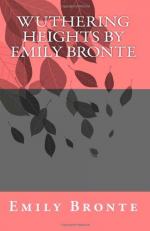|
This section contains 268 words (approx. 1 page at 400 words per page) |

|
Wuthering Heights Summary & Study Guide Description
Wuthering Heights Summary & Study Guide includes comprehensive information and analysis to help you understand the book. This study guide contains the following sections:
This detailed literature summary also contains Bibliography and a Free Quiz on Wuthering Heights by Emily Brontë.
First published m 1847, Emily Brontë's Wuthering Heights ranks high on the list of major works of English literature A brooding tale of passion and revenge set in the Yorkshire moors, the novel has inspired no fewer than four film versions in modern times. Early critics did not like the work, citing its excess of passion and its coarseness. A second edition was published in 1850, two years after the author's death. Sympathetically prefaced by her sister Charlotte, it met with greater success, and the novel has continued to grow in stature ever since. In the novel a pair of narrators, Mr Lockwood and Nelly Dean, relate the story of the foundling Heathcliff s arrival at Wuthering Heights, and the close-knit bond he forms with his benefactor's daughter, Catherine Earnshaw. One in spirit, they are nonetheless social unequals, and the saga of frustrated yearning and destruction that follows Catherine's refusal to marry Heathcliff is unique in the English canon. The novel is admired not least for the power of its imagery, its complex structure, and its ambiguity, the very elements that confounded its first critics. Emily Brontë spent her short life mostly at home, and apart from her own fertile imagination, she drew her inspiration from the local landscape the surrounding moorlands and the regional architecture of the Yorkshire area-as well as her personal experience of religion, of folklore, and of illness and death. Dealing with themes of nature, cruelty, social position, and indestructibility of the spirit, Wuthering Heights has surpassed the more successful Charlotte Brontë's Jane Eyre in academic and popular circles.
Read more from the Study Guide
|
This section contains 268 words (approx. 1 page at 400 words per page) |

|



